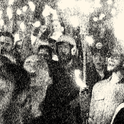Last night’s US Navy cruise missile bombardment of the Syrian Air Force’s Shayrat airfield near the western city of Homs was, on the face of it, an immediate retaliatory strike against the squadron responsible for dropping chemical weapons—including the nerve agent Sarin—on civilians at Khan Sheikhoun in Idlib province. Fifty-nine BGM-109 Tomahawk Land Attack Cruise Missiles (TLAMs) were fired from two US Navy warships in the Eastern Mediterranean and are said to have targeted aircraft, hangers, fuel dumps, munitions stockpiles and radar installations at Shayrat. However, the effectiveness of this attack beyond pure symbolism is highly questionable.
Russia has previously used Shayrat as a forward operating base for helicopter gunships conducting missions alongside the Syrian Army, and has large number of specialists of various sorts embedded within the Syrian military. This meant that in order to avoid any possibility of inadvertently killing Russian military personnel in this large scale cruise missile strike, the US Military had to give the Russian command chain in Syria sufficient warning to evacuate personnel, critical equipment and serviceable aircraft that they might have had at Shayrat. Since Russia is closely allied with the Assad regime, it is almost inconceivable that this warning would not have been passed on to the Syrian Air Force—giving the latter time to evacuate its own serviceable aircraft, key mobile equipment and personnel from the base before the Tomahawks hit. Therefore, the US Navy has most likely expended over $100m in cruise missiles to bombard a mostly empty forward airbase. Granted, the Syrian Air Force will not have had time to remove everything of value, and the destruction of the airbase as a viable operating location until repairs can be affected will certainly be an operational blow to the regime in the Homs area. However, it is far from a paralysing strike and certainly will not be sufficient to force a major policy shift by Bashar al-Assad in the gruelling civil war.
The strikes have also seriously irritated Russia, as the Kremlin statements so far make clear. This is a problem because any long-term solutions or further large scale military action in Syria against the Assad regime will require Russian cooperation. Russia operates a formidable air defence network from its bases at Latakia and Tartus, as well as possessing air superiority fighters and naval assets in the Eastern Mediterranean. The end of Russian-Coalition deconfliction arrangements for strikes against Daesh in Syria has already been announced by President Vladimir Putin, as has an increase in Syrian air defences going forwards. What this effectively means is that US and coalition freedom of action in the skies above most of central, western and north-western Syria has been significantly curtailed as a result of these strikes, and Russia is signalling that it is taking measures to prevent a follow-on campaign to militarily remove President Assad from power.
Russia is not wedded to Assad at a personal level, but it has invested significant geopolitical capital, as well as military force, to set itself up as the defender of non-western aligned regimes from what it portrays as illegal regime change attempts. President Putin would, therefore, demand a very high diplomatic price for any deal which enables further US-led efforts to remove Assad. Official recognition of Russian control of Crimea, a free hand in Eastern Ukraine and the removal of western forces reinforcing the Baltic States on NATO’s Eastern flank would certainly be on the Russian list of demands, and it is hard to see an end-result in Syria justifying that political price for the US and NATO going forwards.
The fundamental problem for President Donald Trump and the west in Syria is that the time to destroy Assad’s air force and air defence networks has come and gone. Furthermore, the moderate opposition forces in Syria have lost so much ground since 2013 that there is not really any credible way that the US military could help roll-back the Assad regime without putting their own boots on the ground—which could lead directly to conflict between US and Russian troops and is highly unlikely to happen.
All in all, everything at this stage points to the US strikes overnight as a one-off symbolic warning and statement of willingness to use force by the Trump administration. However, the damage inflicted is relatively negligible, the price in terms of complicating future air operations against Daesh in Syria is high, and military options to force Assad out of power remain at least as unpalatable as they were in 2013. The Trump administration is running up against the same dilemma as that faced by Obama in 2013; a desire and imperative to respond militarily against an egregious violation of international law, but with no good options to do so and still no answers to how to bring the bloody conflict in Syria to an end.
Syrian missile attack: a statement of willingness to use force
But the military options to force Assad out of power remain at least as unpalatable as they were in 2013
April 07, 2017

A satellite photo of the Shayrat Airfield in Syria, released by the Pentagon ©USA TODAY Network/SIPA USA/PA Images












